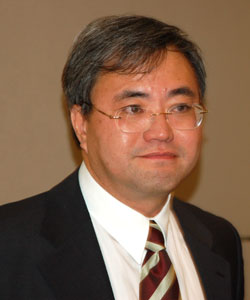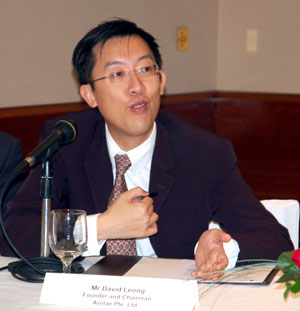 Global warming: Patagonia 75 years ago and what is today (below). Images from Al Gore's movie An Inconvenient TruthIN THE movie, An Inconvenient Truth, Al Gore is on stage expounding on the threats of climatic change. He projects a graph to show how atmospheric carbon dioxide has risen sharply over the years.
Global warming: Patagonia 75 years ago and what is today (below). Images from Al Gore's movie An Inconvenient TruthIN THE movie, An Inconvenient Truth, Al Gore is on stage expounding on the threats of climatic change. He projects a graph to show how atmospheric carbon dioxide has risen sharply over the years.
He then climbs into a cherry picker which rises so high, he is almost up to the ceiling.
It is a dramatic moment which dramatizes the prediction that the level of carbon dioxide may be way off the chart in the future.
 Today, at Patagonia in Argentina: Gone are the glaciers and snow-capped mountains.Such high levels of carbon dioxide will lead to a sharp rise in global warming as the gas' molecular structure traps heat near the Earth's surface. Parts of ice caps will melt, cities drown, storms turn more violent.
Today, at Patagonia in Argentina: Gone are the glaciers and snow-capped mountains.Such high levels of carbon dioxide will lead to a sharp rise in global warming as the gas' molecular structure traps heat near the Earth's surface. Parts of ice caps will melt, cities drown, storms turn more violent.
Over the last weekend, Al Gore, the tireless champion of the environment and a former US vice-president, shared the Nobel Prize for Peace 2007 with the United Nations' Intergovernmental Panel on Climate Change.
The spectre of climate change he painted is already being addressed in many ways, including through the Kyoto Protocol signed by 169 countries which commit to reduce greenhouse gas emissions by at least 5% from 1990 levels in the period 2008-2012.
Under the protocol, agreed 'caps' are set on the amount of greenhouse gases each country can produce. In turn, these countries set quotas on local businesses.
Those that have not used up their quotas can sell their unused allowances as carbon credits, while businesses that are about to exceed their quotas can buy the extra allowances as credits, privately or on the open market.
Aretae’s 50 million carbon credits worth $1.75 billion?
A Singapore company, Aretae, has emerged to: Dr Stephen Lee: Has 25 years of experience in environmental engineering, transporation, infrastructure construction and maintenance. * Offer integrated services to identify, develop and finance projects that can reduce greenhouse gas emissions;
Dr Stephen Lee: Has 25 years of experience in environmental engineering, transporation, infrastructure construction and maintenance. * Offer integrated services to identify, develop and finance projects that can reduce greenhouse gas emissions;
* Recycle waste of clients’ operations into value-added byproducts or energy;
* Invest independently or with partners in such projects.
To date, Aretae has secured over 30 greenhouse gas reduction projects, which are expected to generate an aggregate of 50 million metric tonnes of carbon credits (see table below) over the lives of these projects, which range from 7 to 10 years.
The current market value for a carbon credit for delivery in December 2008 is about Euro 17 or S$35.
Based on simple calculations, Aretae’s credits are potentially worth about $1.75 billion.
An estimated US$22 billion of carbon credits was traded in carbon market in the first half of 2007 with an annualized growth of over 40%.  Dr Low Chin Nam: Started career in Admin Service of government, then divisional director at Keppel T&T, COO of M1 and MD of Digiland.The global carbon market is expected to enter into a new phase of development in 2008. Carbon credits are now being transformed from a niche commodity into an established asset class, says Dr Stephen Lee, managing director of Aretae.
Dr Low Chin Nam: Started career in Admin Service of government, then divisional director at Keppel T&T, COO of M1 and MD of Digiland.The global carbon market is expected to enter into a new phase of development in 2008. Carbon credits are now being transformed from a niche commodity into an established asset class, says Dr Stephen Lee, managing director of Aretae.
While the carbon credits generated by Aretae’s over 30 green house gas reduction projects provide an important revenue stream, the core long-term revenue will come from the sale of waste by-products such as compost/fertilizer, and electricity from the renewable energy business, says Aretae’s CEO, Dr Low Chin Nam.
Aretae’s current project portfolio includes converting agricultural waste into compost/fertiliser or energy, and landfill gas into energy in Malaysia, Indonesia, Vietnam, China and Singapore.
Aretae’s $600-m reverse takeover of Oculus
Oculus has entered into an agreement to acquire the entire issued share capital of Aretae for S$600 million to be paid through an issue of 1.2 billion shares in the capital of Oculus at S$0.50 per share, a premium to the last traded price of 40.5 cents.
 CDM: Clean Development Mechanism, an arrangement under the Kyoto Protocol. One CER (carbon emission reduction) stands for the reduction of CO2 emissions by 1 ton
CDM: Clean Development Mechanism, an arrangement under the Kyoto Protocol. One CER (carbon emission reduction) stands for the reduction of CO2 emissions by 1 ton
To inject a strong vote of confidence into the deal, the key vendors of Aretae will provide an earnings guarantee of not less than S$50 million for aggregate earnings before interest, tax, depreciation and amortization (“EBITDA”) of Aretae for the financial years ending 31 December 2008 and 31 December 2009.
The key vendors expect the EBITDA figures for FY2008 and FY2009 to be S$20 million and S$30 million, respectively.
”The new business injection will help to create very significant shareholders’ value and attract more institutional interest to the company,” says Oculus executive director Low Shiong Jin.
The following are highlights of the Q&A session held during a briefing for analysts and journalists at Fullerton Hotel yesterday (Tuesday, Oct 16). David Leong, 37, founder and chairman of Aretae, and T.C. Tan, non-executive director of Aretae, provided the answers. The text has been edited for brevity.
Q: Can you provide a breakdown of the shareholders of Aretae?
David: The key vendors own 70% of the company and they are present here: myself, Dr Stephen Lee, T.C. Tan and, to a certain extent, Dr Low Chin Nam.
Q: What is your service model? How do you go about getting projects? And as for your carbon credits, is there profit-sharing with the companies?
 Briefing at Fullerton Hotel: More than 60 analysts, investors and journalists turned up. Picture by Sim Kih
Briefing at Fullerton Hotel: More than 60 analysts, investors and journalists turned up. Picture by Sim Kih
David: For each project, the model we work with our client may be slightly different, depending on several factors. In the most extreme case, our clients engage us to help them register and set up a CDM (Clean Development Mechanism) project. We manage and market the carbon credits on their behalf. Under that model, we will share revenue with them.
At the other extreme, such as a landfill project, we will become the project owner and pay for everything. We will receive the bulk of the revenue.
In other cases, companies engage us as a joint venture partner and put up the capital. We manage the project and share the revenue. David Leong: co-founded Aretae in 1996 as an Internet and wireless consulting company, built it up to 200 employees in 4 countries; driving force behind Aretae's development in the carbon credits market since 2006.Our business model is based on more and more projects while existing projects continue to generate revenue for us through the sale of carbon credits and electricity, etc.
David Leong: co-founded Aretae in 1996 as an Internet and wireless consulting company, built it up to 200 employees in 4 countries; driving force behind Aretae's development in the carbon credits market since 2006.Our business model is based on more and more projects while existing projects continue to generate revenue for us through the sale of carbon credits and electricity, etc.
We engage with owners or state or provincial governments, and once we start on a project we typically spend six months to a year to get it up and running. Once it is operational, a lot of the projects typically run by themselves.
Q: You have given a profit warranty for 2008 and 2008. What’s Aretae’s profit for 2007? If you can’t achieve the profit warranty, will there be a share reduction or a cash top-up?
David: If the warranty is not achieved, there will be a cancellation of shares of the key vendors according to a formula. It will not be paid for in cash as that would not be fair.
We will not have any significant earnings for 2007. No comparable company is making money in ’07 for the simple reason that the crediting period starts in ’08. A few months ago, there were probably 400 registered projects. Today, there are 800.
It is a land-grab situation. Our earnings warranty is based on our projects coming online and those already running.

TC Tan: To add to David’s answer, you have to look at our business model as being different from the conventional. This is a new emerging business. Why we the key vendors are putting up our shares as deposit as it were is, we are confident of this business. We are going to be the largest or leading player in Asia.
Q: Aretae is managing 50 million carbon credits worth $35 each – is that right? What impact does that have on the valuation of your shares?
David: Our company also offers services as carbon asset management. With all these credits, you need someone to manage it. For our own projects and joint ventures, there is a market for the credits. Its value fluctuates.
The price is closely related to the oil price because a lot of the buyers are

utility players. They have a choice between burning coal or natural gas or diesel. Each tonne that they use, they have to find an allowance. The company that owns carbon credits have to take a position and manage it.
TC Tan: If you do a simple calculation by multiplying by $35, the 50 million credits are worth a certain amount. But we will be managing and optimising that. We may get, for example, $2.5 billion (instead of S$1.75 billion based on a direct simple calculation).
All photos of Aretae and Oculus management were shot by Sim Kih of NextInsight Pte Ltd.
Click here for Oculus' announcements on the reverse takeover.
Aretae's website is: www.aretae.com



